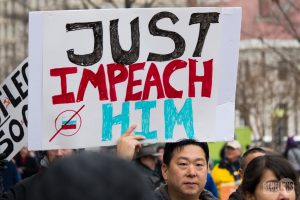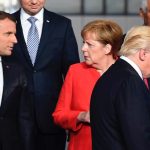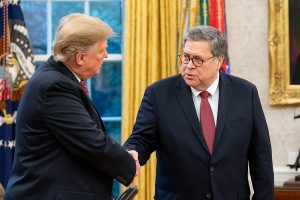by John Feffer
Let me start with a confession. I’m old-fashioned and I have an old-fashioned profession. I’m a geo-paleontologist. That means I dig around in archives to exhume the extinct: all the empires and federations and territorial unions that have passed into history. I practically created the profession of geo-paleontology as a young scholar in 2020. (We used to joke that we were the only historians with true 2020 hindsight). Now, my profession is becoming as extinct as its subject matter.
Today, in 2050, fewer and fewer people can recall what it was like to live among those leviathans. Back in my youth, we imagined that lumbering dinosaurs like Russia and China and the European Union would endure regardless of the global convulsions taking place around them. Of course, at that time, our United States still functioned as its name suggests rather than as a motley collection of regional fragments that today fight over a shrinking resource base.
Empires, like adolescents, think they’ll live forever. In geopolitics, as in biology, expiration dates are never visible. When death comes, it’s always a shock.
Consider the clash of the titans in World War I. Four enormous empires — the Ottoman, Austro-Hungarian, Russian, and German — went into that conflict imagining that victory would give them not just a new lease on life, but possibly even more territory to call their own. And all four came crashing down. The war was horrific enough, but the aftershocks just kept piling up the bodies. The flu epidemic of 1918-1919 alone — which soldiers unwittingly transported from the trenches to their homelands — wiped out at least 50 million people worldwide.
When dinosaurs collapse, they crush all manner of smaller creatures beneath them. No one today remembers the death throes of the last of the colonial empires in the mid-twentieth century with their staggering population transfers, fierce insurgencies, and endless proxy wars — even if the infant states that emerged from those bloody afterbirths gained at least a measure of independence.
My own specialty as a geo-paleontologist has been the post-1989 period. The break-up of the Soviet Union heralded the last phase of decolonization. So, too, did the redrawing of boundaries that took place in parts of Asia and Africa from the 1990s into the twenty-first century, producing new states like East Timor, Eritrea, South Sudan. The break-up of the Middle East, in the aftermath of the U.S. invasion of Iraq and the “Arab Spring,” followed a similar, if far more chaotic and bloody pattern, though religious extremism more than nationalist sentiment tore apart the multiethnic countries of the region.
Even in this inhospitable environment, the future still seemed to belong to the dinosaurs. Despite setbacks, the U.S. continued to loom over the rest of the planet as the “sole superpower,” with its military in constant intervention mode. China was on the rise. Russia seemed bent on reconstituting the old Soviet Union. The need to compete on an increasingly interconnected planet contributed to what seemed like a trend: pushing countries together to create economies of scale. The European Union (EU) deepened its integration and expanded its membership. Nations of very different backgrounds formed economic pacts like the Association of Southeast Asian Nations (ASEAN) and the North American Free Trade Agreement (NAFTA). Even countries without any shared borders contemplated such joint enterprises, like the Organization of Petroleum Exporting Countries (OPEC) and, later, Brazil, Russia, India, China, and South Africa (the “BRICS” nations).
As everyone now knows, however, this spirit of integration would, in the end, go down to defeat as the bloodlands of the twentieth century gave way to the splinterlands of the twenty-first. The sense of disintegration and disunity that settled over our world came at precisely the wrong moment. To combat a host of collective problems, we needed more unity, not less. As we are all learning the hard way, a planet divided against itself will not long stand.
The Wrath of Nations
Water boils most fiercely just before it disappears. And so it is, evidently, with human affairs.
Just before all hell broke lose in 1914, the world witnessed an unprecedented explosion of global trade at levels that would not be seen again until the 1980s. Just before the Nazis took over in 1932, Germans in the Weimar Republic were enjoying an extraordinary blossoming of cultural and political liberalism. Just before the Soviet Union imploded in 1991, Soviet scholars were pointing proudly to rising rates of intermarriage among the many nationalities of the federation as a sign of ever-greater social cohesion.
And in 2015, just before the great unraveling, the world still seemed to be in the grip of what was then labeled “globalization.” The volume of world trade was at an all-time high. Facebook had created a network of 1.5 billion active users. People on every continent were dancing to Drake, watching the World Cup final, and eating sushi. At the other end of the socio-economic spectrum, more people were on the move as migrants and refugees than at any timesince the end of World War II.
Borders seemed to be crumbling everywhere.
Before 2015, almost everyone believed that time’s arrow pointed in the direction of greater integration. Some hoped (and others feared) that the world was converging on ever-larger conglomerations of nations. The internationalists campaigned for a United Nations that had some actual political power. The free traders imagined a frictionless global market where identical superstores would sell the same products at all their global locations. The technotopians imagined a world united by Twitter and Instagram.
In 2015, people were so busy crossing borders — real and conceptual — that they barely registered the backlash against globalization. Officially, more and more countries had committed themselves to diversity, multiculturalism, and the cosmopolitan ideals of liberty, solidarity, and equality. But everything began to change in 2015, a phenomenon I first chronicled in my landmark study Splinterlands (Dispatch Books, 2025). The movements that came to the fore in 2015 championed a historic turn inward: the erection of walls, the enforcement of homogeneity, and the trumpeting of exclusively national virtues.
The leaders of these movements — Donald Trump in the United States, Hungarian Prime Minister Viktor Orban, Russian President Vladimir Putin, French National Front Party leader Marine Le Pen, Indian Prime Minister Nahendra Modi, Japanese Prime Minister Shinzo Abe, and Egyptian President Abdel Fattah el-Sisi, to name just a few — were not members of a single party. They did not consider themselves part of a single movement. Indeed, they were quite skeptical of anything that smacked of transnational cooperation. Personally, they were cosmopolitans, comfortable in a variety of cultural environments, but their politics were parochial. As a group, they heralded a change in world politics still working itself out 35 years later.
Ironically enough, at the time these figures were the ones labeled “dinosaurs” because of their focus on imaginary golden ages of the past. But when history presses the rewind button, as it has for the last 35 years, it can turn reactionaries into visionaries.
Few serious thinkers during the waning days of the Cold War imagined that, in the long run, nationalism would survive as anything more significant than flag and anthem. As the historian Eric Hobsbawm concluded in 1990, that force was almost spent, or as he put it, “no longer a major vector of historical development.” Commerce and the voracious desire for wealth were expected to rub away at national differences until all that remained would be a single global marketplace of supposedly rational actors. New technologies of travel and communication would unite strangers and dissolve the passions of particularism. The enormous bloodlettings that nations visited on one another in the nineteenth and twentieth centuries would surely convince all but the lunatic that appeals to motherland and fatherland had no place in a modern society.
As it turned out, however, commerce and its relentless push for comparative advantage merely rebranded nationalism as another marketable commodity. Although travel and communication did indeed bring people together, they also increased the opportunities for misunderstanding and conflict. As a result, nationalism did not go gently into the night. Quite the opposite: it literally remapped the world we now live in.
The Fracture Lines
The fracturing of the so-called international community did not happen with one momentous crack. Rather, it proceeded much like the calving of Arctic ice masses under the pressure of global warming, leaving behind only a herd of modest ice floes. Rising geopolitical temperatures had a similar effect on the world’s map.
At first, it was difficult to understand how the war in Syria, the conflict in Ukraine, the simmering discontent in Xinjiang, the uprisings in Mali, the crisis of the Europe Union, and the upsurge in anti-immigrant sentiment in both Europe and the United States were connected. But connected they were.
The initial cracks in that now-dead global system appeared in the Middle East. As a geo-paleontologist, I must admit that I wasn’t particularly interested in those changes themselves, only in their impact on larger entities. Iraq and Syria, multiethnic countries forged in the post-colonial fires of Arab nationalism, split along ethnic and confessional lines. Under the pressure of a NATO air intervention led by the U.S., Libya similarly fell apart when its autocratic leader was killed and its arsenals were pillaged and sent to terror groups across a broad crescent of crisis. The fracturing then continued to spread — to Yemen, Egypt, Saudi Arabia, Lebanon, and Jordan. People poured out of these disintegrating countries like creatures fleeing a forest fire.
This vast flood of refugees by land and sea proved to be the tipping point for the European Union. Having expanded dramatically in the 2000s, the 28-member association hit a wall of Euroskepticism, fiscal austerity, and xenophobia. As they reacted to the rising tide of refugees, the anti-immigrant forces managed to end the Schengen system of open borders. Next to unravel was the European currency system as the highly indebted countries on the periphery of the Eurozone reasserted their fiscal sovereignty.
The Euroskeptics took heart from these developments. In 2015, the anti-immigrant Democratic Party in Sweden leaped to the top of the opinion polls for the first time. Once the epitome of tolerance and social democracy, Sweden led the great turn in Scandinavia away from the European mainland. On the heels of local elections and those for the European Parliament, the far-right National Front of Marine Le Pen became the most popular French party and, with its newfound power, began to pry apart the informal pact with Germany that had once been the engine for European integration. Euroskeptical parties consolidated power in Poland, Portugal, Hungary, and Slovakia. Desperate to curry favor with its hardcore constituents, the British Conservative Party sponsored a referendum that guided Great Britain out of the EU. What had once been only scattered voices of dissatisfaction suddenly became a rush to the exits. The EU survived for some years more — until the Acts of Dis-Integration of 2028 — but only as a shell.
The unrest in the Middle East and the unraveling of the EU had a profound impact on Russia. The last of that country’s Soviet-era politicians had been attempting to reconstruct the old federation through new Eurasian arrangements. At the same time, they were trying to expand jurisdiction over Russian-speaking populations through border wars with Ukraine, Georgia, and Moldova. But in their grab for more, they were left with less. Mother Russia could no longer corral its children, neither the Buryats of the trans-Baikal region nor the Sakha of Siberia, neither the inhabitants of westernmost Kaliningrad nor those of the maritime regions of Primorye in the far east. Moscow’s entrance into the Syrian conflict on the side of Damascus contributed to an upsurge in separatist sentiment in the trans-Caucasus republics of Chechnya and Dagestan. In the Second Great Perestroika of 2031, Russia divided along the lines we know so well today, separating its European and Asian halves and its industrial wastelands in the north from its creeping deserts in the south.
China found itself on a similar trajectory. A global economic slowdown frayed the unstated social contract — incremental improvements in prosperity in exchange for political quiescence — that the Communist Party had developed in the wake of the Tiananmen Square protests of 1989. Beijing’s crackdown on anything that smacked of “terrorism” only pushed the Uighurs of Xinjiang into open revolt. The Tibetans, too, continued to advance their claims for greater autonomy. Inner Mongolia, with almost twice as manyethnic Mongolians as Mongolia itself, also pulled at the strings that held China together. Taiwan stopped talking about cross-Straits reunification; Hong Kong reasserted its earlier status as an entrepôt city. But these rebellions along the frontiers paled in comparison to the Middle Uprising of the 2030s. In retrospect, it was obvious that the underemployed workers and farmers in China’s heartland, who had only marginally benefited from the country’s great capitalist leap forward of the late twentieth century, would attack the political order. But who would have thought that the middle could drop so quickly out of the Middle Kingdom?
The United States, as we all know, has not fallen apart. But the American empire (which U.S. leaders took such pains to deny ever existed) has effectively collapsed. Once the U.S. government went into receivership over its mountainous debt and its infrastructure began to truly collapse, its vast overseas military footprint became unsupportable. As it withdrew, Washington deputized its allies — Germany, Japan, South Korea, Saudi Arabia, and Israel — to do the same work, but they regularly worked at cross-purposes and in any case held their own national interests above those of Washington.
Meanwhile, U.S. domestic politics remained so polarized and congealed that Congress and the executive branch could not establish a consensus on how to re-energize the economy or reconceive the “national interest.” Up went higher walls to keep out foreigners and foreign products. With the exception of military affairs and immigration control, the government dwindled to the status of caretaker. Then there was the epidemic of assault rifles, armed personal drones, and WBA (weaponized biological agents), all easily downloaded at home on 3-D printers. The state lost its traditionally inviolable monopoly on violence and our society, though many refuse to acknowledge the trend, drifted into a condition closely approximating psychosis. An increasingly embittered and armed white minority seemed determined to adopt a scorched-earth policy rather than leave anything of value to its mixed-race heirs. Today, of course, the country exists in name alone, for the only policies that matter are enacted on a regional basis.
The centrifugal forces first set in motion in 2015 tore apart the great multiethnic nations in a terrifying version of Yugoslavization that spread across the planet. Farseeing pundits had predicted a wave of separatism in the 1990s. They were wrong only in terms of pace. The fissures were slower to appear, but appear they did. In South Asia, separatist movements ate away at both India and Pakistan. In Southeast Asia, Indonesia, Malaysia, and Myanmar fractured along ethnic lines. In Africa, the center could not hold, and things inevitably fell apart — in the Congo, the Central African Republic, Nigeria, and Chad, among other places.
There was much talk in the early twenty-first century of failed states like Afghanistan, Iraq, Somalia, Yemen, and Haiti. Looking back, it’s now far clearer that, in a certain sense, all states were failing. They had little chance against the governance-eroding winds of globalization from above and the ever-greater upheavals of non-state actors from below.
Perhaps under the best of environmental conditions, these forces would have pushed empires, federations, and trade pacts to the edge but no further. As it happened, however, despite conferences and manifestos and sort-of-binding agreements, the global thermometer continued to rise. The effects of climate change turned out to be the proverbial tipping point. Water shortages intensified conflict throughout China, as did food shortages in Russia. The tropics, the islands, the coastlines: all were vulnerable to the rising waters. And virtually every country entered into a pitched battle over drinking water, clean air, indispensible minerals, and arable land.
All of us have our own personal climate-change disaster stories. For instance, I lost my home in Hurricane Donald, which destroyed so much of Washington, D.C. and its suburbs in 2029. I started all over in Nebraska only to be forced to move again when the Oglala aquifer gave out in 2034, precipitating what we now call the Midwest Megadrought. And like so many others, I lost a loved one only three years ago in that terrible month of superstorms — 7/47 — which devastated such a large swath of the planet.
What no one anticipated was the impact climate change would have on nationalism. But how else would people divvy up increasingly precious natural resources? National sentiment proved to be the go-to principle for determining what “our” people deserved and those “others” didn’t. As a result, instead of becoming an atavistic remnant of another age, nationalism has proved to be this century’s most potent ideology. On an increasingly desperate planet, we face not the benevolence or tyranny of one world, but the multiple confusions of many worlds.
All That Was Solid
It was not only the multiethnic nation-state that proved untenable in our century. Everything seemed to be fracturing.
The middle class shattered. The promise of a stable job and income — the iron rice bowl in the East and the ironclad pension in the West — disappeared into a maelstrom of inequality in which the super-rich 1% effectively seceded from society while the poorest of the poor had nowhere to turn. Back in 2015, pundits loved to promote new trends like the “sharing economy” of millions of employees turned entrepreneurs or the “long tail” of a splintering consumer market. But the bottom line was grimly straightforward: the forces that could have acted to countervail the fissiparous competition of the market gradually disappeared. Gone was the guiding hand of the government. Gone were the restraining pressures of morality.
Technology certainly played a role in this transformation, first when computers and cell phones untethered individuals from fixed workplaces and then when biochips turned each individual into his or her own “work station.” The application of market principles to every facet of existence whittled away the public sphere in favor of the private one. Such dynamics at the social level also contributed to the great fracturing that took place in the international sphere.
Yes, I can anticipate your criticism. Perhaps it’s true that, in 2050, we are at a nadir of cooperation and some new form of centralization and globalization lies ahead. Clearly, the jihadis, who operate their mini-caliphates around the world, dream of uniting the faithful under a single banner. There are diplomats even today who hope to get all 300-plus members of the United Nations to agree to the sort of institutional reforms that could provide the world with some semblance of global governance. And maybe a brilliant programmer is even now creating a new “killer app” that will put every single person on the same page, literally.
As a geo-paleontologist, I am reluctant to speculate. I focus on the past, on what has actually happened. Anyone can make predictions. But none of these scenarios of future integration seems at all plausible to me. “That’s the way the cookie crumbles,” we used to say when I was a kid. And a cookie can only crumble in one direction.
Still, I would be remiss if I didn’t point out something that many have noted over the years. We have been fragmenting at precisely the time when we should be coming together, for the problems that face the planet cannot be solved by millions of individuals or masses of statelets acting alone. And yet how can we expect, with desperate millions on the move, the rise of pandemics, and the deepening of economic inequality globally, that people can unite against common existential threats? Only today can we all see clearly, as I wrote so many years ago, that the rise of the splinterlands has been humanity’s true tragedy. The inability of cultures to compromise within single states, it seems, anticipated our current moment when multiplying nation-states can’t compromise on a single planet to address our global scourges. The glue that once held us together — namely, solidarity across religion, ethnicity, and class — has lost its binding force.
At the beginning of the great unraveling, in 2015, I was still a young man. Like everyone else, I didn’t see this coming. We all lived in a common home, I thought. Some rooms were in terrible disrepair. Those living in the attic were often exposed to the elements. The house as a whole needed better insulation, more efficient appliances, solar panels on the roof, and we had indeed fallen behind on the mortgage payments. But like so many of my peers, I seldom doubted that we could scrape together the funds and the will to make the necessary repairs by asking the richer residents of the house to pay their fair share.
Thirty-five years and endless catastrophes later on a poorer, bleaker, less hospitable planet, it’s clear that we just weren’t paying sufficient attention. Had we been listening, we would have heard the termites. There, in the basement of our common home, they were eating the very foundations out from under us. Suddenly, before we knew quite what was happening, all that was solid had melted into air.
Reprinted with permission from TomDispatch. Photo courtesy of Nesster via Flickr.
John Feffer is the director of Foreign Policy In Focus at the Institute for Policy Studies, the editor of LobeLog, a TomDispatch regular, and the author of several books, including Crusade 2.0. Follow TomDispatch on Twitter and join us on Facebook. Check out the newest Dispatch Book, Nick Turse’s Tomorrow’s Battlefield: U.S. Proxy Wars and Secret Ops in Africa, and Tom Engelhardt’s latest book, Shadow Government: Surveillance, Secret Wars, and a Global Security State in a Single-Superpower World. Copyright 2015 John Feffer






I opposed western military intervention in Libya, fearing it would lead to a great increase in illegal migration into Europe from Africa. And I thought Obama should have done his best to prevent civil war from erupting in Syria. Pressure on the EU from illegal immigration is enormous, though most Americans are not aware of this fact.
Gee, I guess turning over the difficult work of global governing to the climate-deniers, trickle-downers, Darwinian fundamentalists, and the rest of the One Percent wasn’t such a good idea after all, huh? Gosh, who knew?